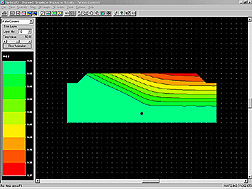Model Predicts Underground Flow
|
|
 The HYDRUS computer model generates outputs like the one above. At a glance, users can see water contents of soils and water movement in a soil profile. (Hydrus) |
Researchers, engineers, extension specialists, and students worldwide can now better understand how water and chemicals move through soil, thanks to one of ARS' most successful cooperative research and development agreements (CRADAs). This CRADA—between the George E. Brown, Jr., Salinity Laboratory (of ARS) in Riverside, California, and the Colorado School of Mines' International Ground Water Modeling Center (IGWMC) in Golden—allows for distribution and continuous improvement of a state-of-the-art computer model named HYDRUS. ARS scientists and collaborators developed the model at the laboratory over the last two decades. The model allows users to simulate, in one or two dimensions, water moving from the soil surface to and into groundwater. They can also use it to visualize how chemicals such as pesticides would be transported in different soils. ARS soil scientist Rien van Genuchten and University of California civil engineer Jirka Simunek are lead authors of the computer program. IGWMC distributes the model, provides hands-on help to users, runs short courses on its use, and gives feedback to ARS so the researchers can improve it. So far, IGWMC has sold more than 500 copies. Four substantial revisions to the program—as well as dozens of minor improvements—have resulted from user feedback. HYDRUS allows agricultural engineers to design irrigation and drainage systems that provide optimal water to crops, while minimizing the transport of fertilizers and pesticides to groundwater. "Rather than doing costly field experiments by trial and error, researchers can use HYDRUS first to find out which scenarios work best," says van Genuchten. Once the program calculates the most realistic situations, a limited number of field experiments can be run to test the results. Too, he says, scientists could use the model to improve the analysis of experiments that have already been carried out and then extrapolate their findings to other locations, crops, or irrigation methods. HYDRUS provides an easy-to-use, Windows-based format. While most groundwater models display results as columns of numbers that can be difficult to interpret and manipulate, HYDRUS displays results visually with graphs or contour lines. It can even use animation to illustrate how a fertilizer, for example, would move through the soil. "The program makes it very easy to model complex systems," says John Selker, an associate professor of bioresource engineering at Oregon State University in Corvallis. Farmers, consultants, and students use it to visualize how different flow processes work in the soil. "It's really quite a remarkable achievement," he says. HYDRUS has also found widespread nonagricultural use. For example, researchers at former nuclear testing facilities in Nevada are using the model to make sure their landfill covers work adequately. These soil covers prevent rainfall and runoff from leaching through the landfill and carrying low-level radionuclides to groundwater. "We're very pleased that many groups outside of agriculture are using HYDRUS," says van Genuchten. For a demonstration version of the model, contact van Genuchten or visit http://www.mines.edu/research/igwmc/zipfiles/ on the World Wide Web.—By Kathryn Barry Stelljes, Agricultural Research Service Information Staff. This research is part of Water Quality and Management, an ARS National Program (#201) described on the World Wide Web at http://www.nps.ars.usda.gov/programs/nrsas.htm. Rien van Genuchten is in the USDA-ARS Soil Physics and Pesticide Research Unit, George E. Brown, Jr., Salinity Laboratory, 450 W. Big Springs Rd., Riverside, CA 92507-4617; phone (909) 369-4847, fax (909) 342-4964. |
|
"Model Predicts Underground Flow" was published in the May 2000 issue of Agricultural Research magazine.
|
|






